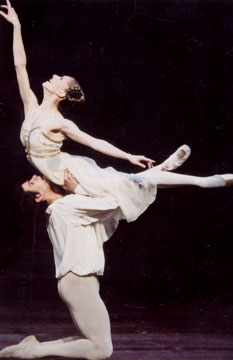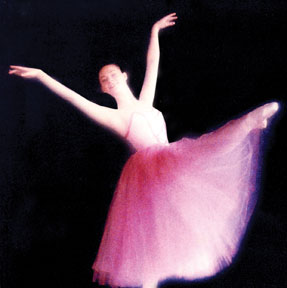Romanticism in ballet
by Gwen Herat
In the pre-Romantic age which is between 1800-1850 when ballet was
stirring, people became curious and showed interest because of the
reason under which ballet came to the notice of the first set of
directors who took notice and moved on. This was followed by the
Romantic Movement where the make believe-world of swan-maidens, sylphs
and fairies dominated the scene, while the dancer was fighting shy to
come out in full bloom.
|

Juliet's anguish before parting a
poignant moment from the ballet,
Romeo and Juliet mounted by the
Royal Ballet, London, displays to
what heights Romantic ballet has
helped achieve spectacular brilliance. |
Like Romantic classical that saw the birth of symphonic and concerto
form mature development of Romantic opera, it also became the age of
piano virtuoso that introduced the nocturnes and symphonic poems. This
is the main reason that Romantic ballet and music has to depend on each
other for survival even today. Romantic ballet gave the impetus to
composers to compose scores mainly for ballet and its movements where
later choreographers depended on them. Then came the Hugh-Romantic
ballet along with music between 1830-1850 and the future.
Vibrant
This provided the dancers to experience a new attitude from tip-toe
movements from its repertoire to the scintillating pointe dancing that
we all dancers dance upon. Associated during this period were some great
dancers who paved the way were Marie Taglioni and Fanny Cerrito. The
glorious production that came on board at this time was Giselle followed
by La Sylphide whose repertoire is still maintained but replaced by
gorgeous costumes. The best Giselle I saw to date is the one danced by
Rudolf Nureyev and Margot Fonteyn.
Today the choreography is different but more important is the fact
that the aura of Romanticism still prevail in classical ballet. Poetic
atmosphere and classicism make ballet more vibrant as it moves into the
new millenium but syllabus remains the same around the world.One would
wonder why toe-dancing assumed such importance during Romanticism. This
is because of the natural continuation of movements demanded by many
Romantic central characters. This offered the ballerina fantastic
taking-off positions of flight and offered a new line of grace. When
pointe dancing resulted from such movements, dazzling feats of turns now
known as Pirouettes became a part of her repertoire.
It left her partner poorer by his dancing but picked up later when
ballet moved into modern repertoire as dance today. In fact, it was
Rudolf Nureyev who placed the male dancer centre-stage giving him such
importance that stunned the ballerina. The use of pointe work produced
gliding effect when Pavlova immortalised The Dying Swan.
It was over a century before that La Camargo introduced the heel-less
flat ballet shoe but it took another century when Taglioni improved on
the existing flat shoe and bring to pointe work for the ballerina get on
her toes and produce new subtleties and create an impression of
weightlessness driving the choreographer into ecstacy.
This was the beginning of the Romantic ballet. Four years later
August Bournoville produced La Sylphide for the Royal Danish Ballet in
Cophenhagen. He used the music of Lovenskjold to replace Schneitzhoffer
original score.
|

From toe-dancing to
pointe work; Today's
excellence in ballet displayed
by a dancer from
the Royal Ballet. |
Conviction
An essential artistic philosophy was awakening fired by the
conviction that Gautier collaborated with Saint-Georges to write the
music for Giselle. Like La Sylphide, Giselle's characters consist of the
real and earthy part and all the requisites of Romantic Ballet. Giselle
is the finest surviving example of the Romantic period and took only ten
days for Adolphe Adams to write the haunting score that is still
maintained by all choreographers who directed the ballet. Giselle is the
finest of all titles that were immortalised by virtuostic ballerinas
such as Anna Pavlova - 1903, Tamara Karsavina - 1910, Olga Spessivtseva
- 1924, Galina Ulanova - 1932, Alicia Markova - 1934, Margot Fonteyn -
1937, Yvette Chauvire - 1944, Svetlana Beriosova - 1956, Lucette Aldous
- 1960, Ekaterina Maximova - 1960, Natalia Markorava - 1961, Natalia
Bessmertnova - 1966, Margeret Barbieri - 1971, and Efa Evdokimova -
1971.
The Paris Opera Ballet to this day, has not recovered from the trauma
it suffered from Romatisicism but still maintains training and producing
remarkable dancers.
But the early years of Romantic ballet had its decline especially in
France but the young composer, Leo Delibes collaborated with the
Hungarian composer, Leon Minkus to score La Source which had already
appeared at the Opera in 1866. Delibes who had thrilling potential as a
ballet composer was responsible for Act II and Act III.
His Coppelia and Sylvia endorsed him as a foremost ballet composer of
the day and urged Delibes' great champion, Tchaikovsky to write him a
letter and say 'Swan Lake is poor stuff compared to Sylvia.' Ballet
raged in other countries generated by Romanticism in France with its
zest and vigour. London too took on to Romantic ballet with enthusiasm
as France reached its culminating point in the 1840s.
But a new force was to come. That is the Russian Imperial Ballet to
be discussed later. |


